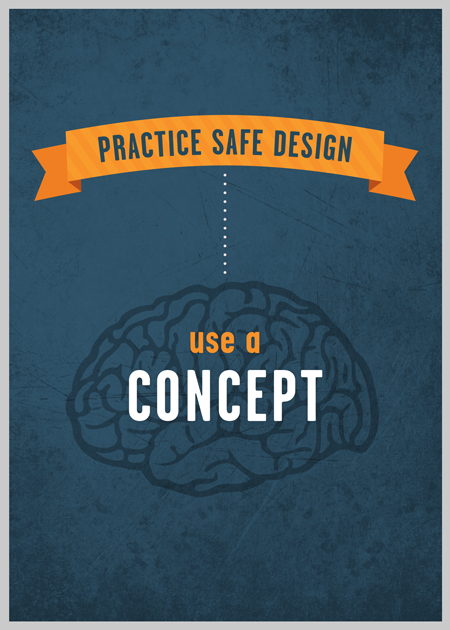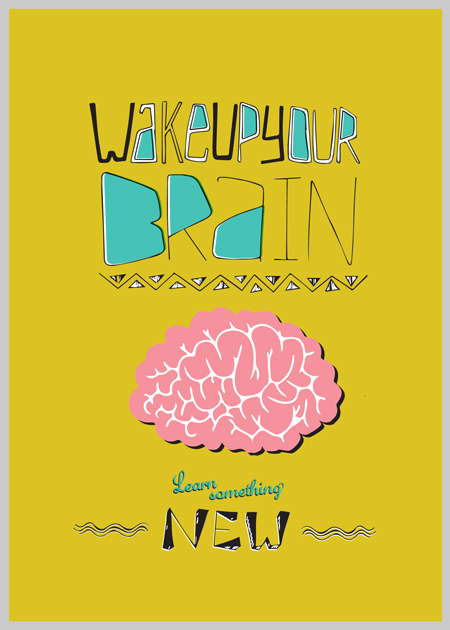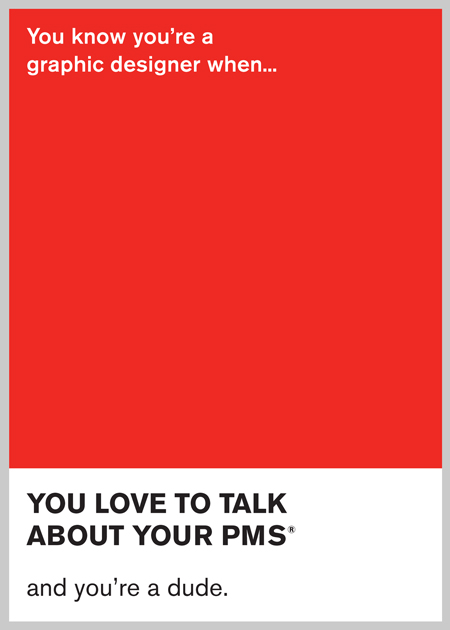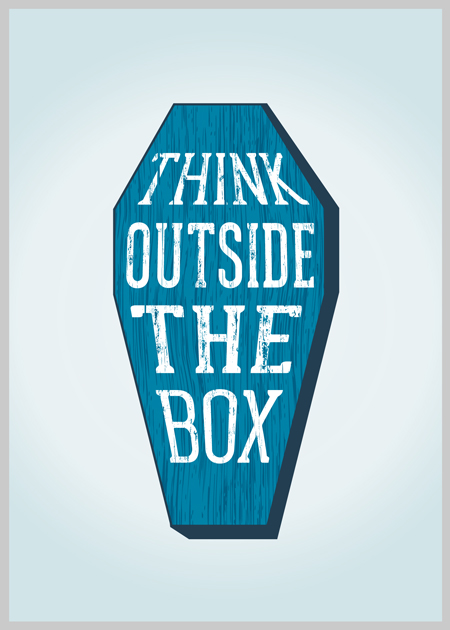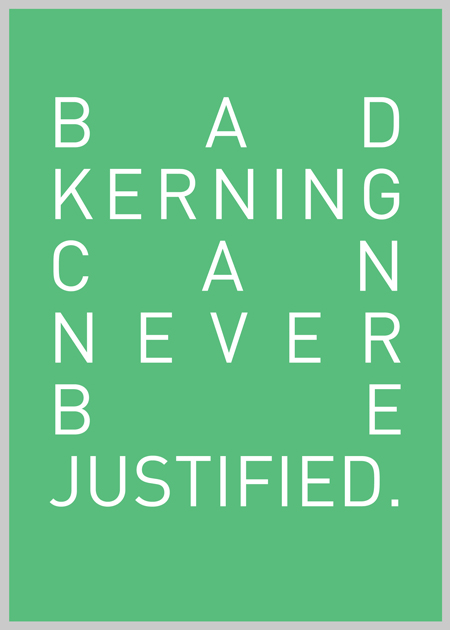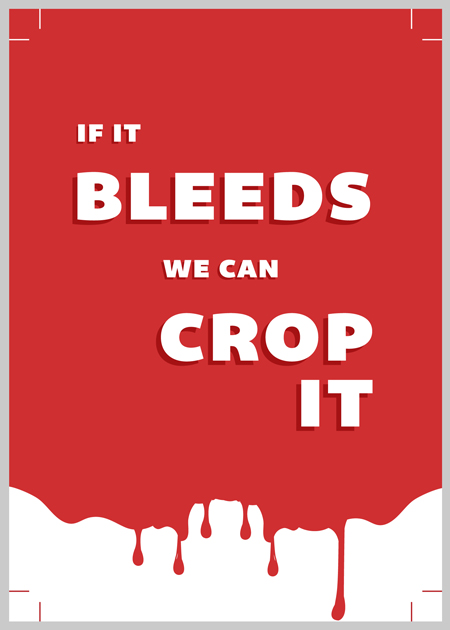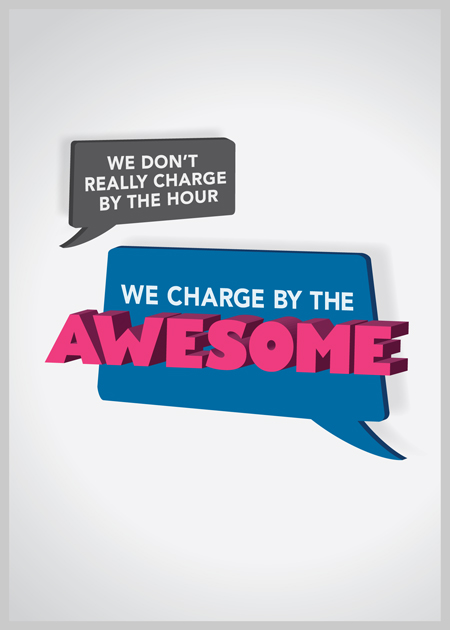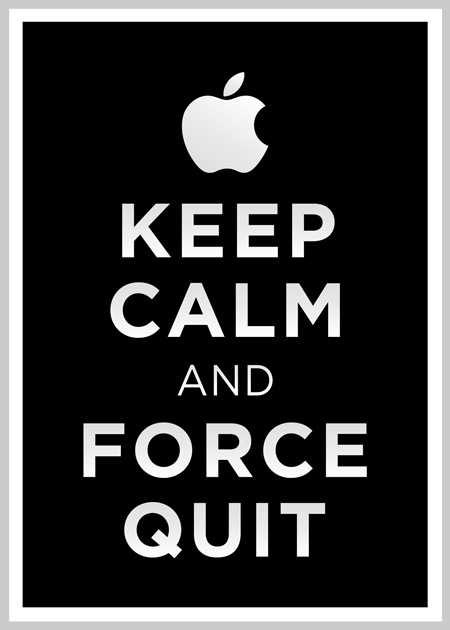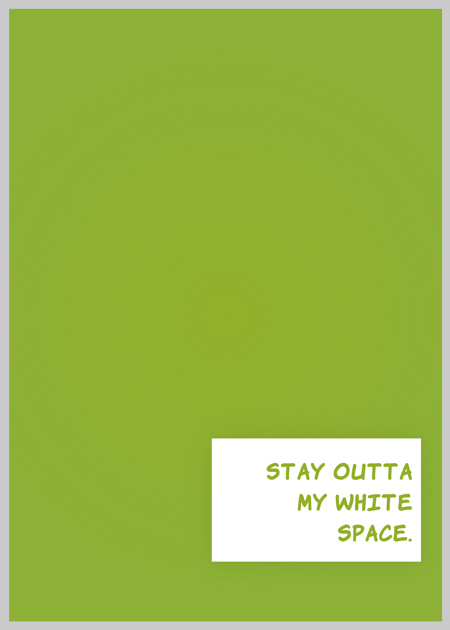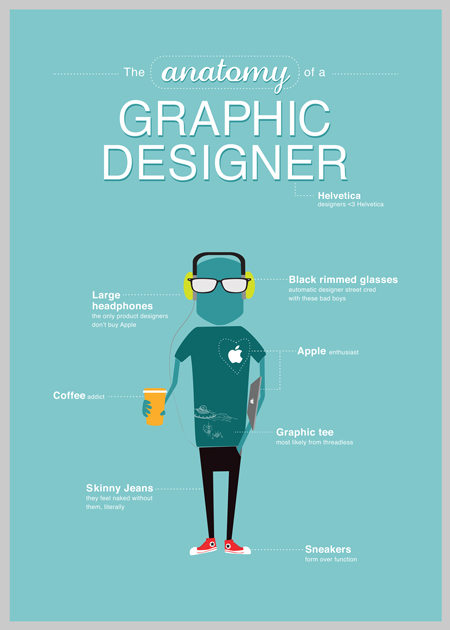People think advertising is easy until they actually have to do it.
It looks fun, but there is some science - and art - to it.
Recently, after going through several rounds of feedback and
revisions -- about two minutes before I'd start pulling out my hair - I had the clients sit with me and said "Let's figure this out together."
I wanted get better feedback so I could properly solve their problems. And more importantly, I wanted them to see my frustrations.
Within the first ten minutes, they were both frustrated. One even said "It's like we're stuck in a box."
I wanted to hug her. WELCOME TO MY LIFE!
Eventually, we found a hole and were able to get out of that box and while it was only a small part of a big project, we all kind of wanted to throw confetti.
I can't always trap the client in a room until we figure something out, of course. Sometimes you just have to try and fail. Then try and fail. Then try and fail again.
But when you do get it (If you get it) it feels like bathing in champagne waterfall at the end of a double rainbow.
Here's a snippet from Art & Copy talking about how the teams came up with "Just Do It"
It wasn't easy. But they did it. And it was (still is) brilliant.
5 common mistakes Juniors should NOT make
Last week, I attended "Where are all the black people" event and
while there were some amazing panels about diversity and young
creatives in advertising, I got to review tons of Juniors' portfolios
and I met some amazing people in the process.
For a while I was the person getting their portfolio reviewed (and
still am actually) but for one day I got to see what it's like to be on
the other side of the table. First of all, I applaud all the young
creatives who were so enthusiastic and received constructive criticism
so gracefully; I know it's hard, but you guys are on the right track I
promise! One more push and you'll be enjoying nights and weekends at
your new agency :D
During the event, I also got to see the common mistakes Juniors make while getting interviewed and presenting their work. A couple of months ago, I wrote a post about networking, which you can revisit. In case you don't know yet, networking is very important and apparently, it's an Art.
Now back to those common mistakes. They are common because A LOT of people make them, don't be one of them. Ask yourself honestly if you make any of the following 5 common mistakes:
1- Eye Contact
Man, that is the worst one for me. If you're sitting in front of someone who took the time off their busy day to come meet with you and help you in your career, the least you can do is PAY ATTENTION when they talk. I understand that a lot of young peeps are ADD, I'm ADD! But come on, show some respect and look at them in the eye. I can't stress it enough, it is such a turn off. This actually happened to me during the event, and for some reason I remember the guy with the wandering eyes very well. Now, that's not how you want people to remember you, do you? F-O-C-U-S
2- Overconfidence
Juniors who think they are the S#*t, yep they exist. A Junior by definition is someone who is starting, who is a beginner hence they don't know S#*t. Being confident is great, being overconfident is simply annoying. Here's the thing, when you're overconfident, you automatically think you know it all, and when you think you know it all you don't have an open mind, when you don't have an open mind, you don't learn anything and when you don't learn anything, you stay a Junior who doesn't know S#*t. Nice little picture I drew for you there huh? Be confident but stay humble.
ADDED BY @THEDAWE: Arrogance is a big one. If you're great, don't worry, you'll have plenty of opportunity to show it, not preach it.
3- Lack of practice
When you go interviewing, you really have to practice your elevator pitch. You gotta know what to say, when to stop and listen and how to answer questions. I had people sit down and hand me their portfolios and wait for feedback. BOOORRRINNNG! I'm already not interested in your work. When you come to interview or show your folio, you have to be ready to speak, show your personality and walk them through your work. People are not going to understand the thinking behind your work unless you tell it. Think of it as storytelling. Go in there, talk about yourself, how you got to where you are, say an anecdote or two, tell them about your work and walk them through it. DON'T EXPLAIN YOUR WORK, just walk them through it. Then ask for feedback, take notes, exchange business cards, thank them for their time and ask if you can connect in LinkedIn later. Then follow up with a written card.
Practice is crucial Juniors, the more you practice, the more you feel confident and the more they'll like you. I talked to some international students–and while I understand that language can be an issue because english is not my first language so I'm on the same boat– It's really hard to communicate with someone you don't understand. So my advice to you guys is to speak loud enough to hear and really practice what you're going to say 100 times. We're in the business of communication and if you can't communicate properly, it will be an issue.
4- Portfolio format
I was SO surprised by the amount of people who brought an actual printed portfolio. I thought those things were long gone? I guess I was wrong. I think 80% of the people I met with had a printed portfolio. Some people will say that there's nothing wrong with a printed portfolio but I disagree. I think a digital portfolio is the way to go. Unless you have some amazing printed art or designs or letterpress or something like that, then go digital. It's cheaper, easier to manage and you don't have to carry it around! Speaking of digital, I was also surprised by the amount of juniors who had only print pieces in their books. Some of them are great ideas that can easily be expanded into digital pieces. My advice to all of you is: Think Campaigns. Show the way you think, explore new and untapped mediums, go all out. Don't do what agencies are doing now, do something different that no one has thought about yet. it's easier said than done, I know. But give it a try.
5- Lack of focus
I understand that sometimes Juniors don't know what they want, they are not sure if they're creative or account or media etc. BUT! when you apply for a job and go for an interview, make sure you don't come off as "Mr know it all" or "Miss I have no clue what I want". I guarantee you won't get a job like that. There are many articles, books, blogs about advertising, it's not that hard to learn about the different departments. Before you go to an interview, make up your mind. Learn as much as you can about the position you're applying for and see if that's something you want to do, if the answer is no, then don't apply. It's a waste of your time and the agency's time. If you need help or advice, seek mentors, ask questions before you start intervewing, that's what I'm here for. On the other hand, don't act like you know it all (Read 2- Overconfidence above). One guys was like, yes I'm a creative, but i can do startegy and consider myself a producer... i was like, dude, pick one, you just listed 3 departments. Don't be that guy. If you can't choose, try to get an internship where they'll let you intern in different departments. You'll eventually find what you want to do.
Overall, I had a blast at the event and I met some really talented people. My last advice to you all is to be fierce. Go get them. Speak up, don't be shy. Go after what you want because if you sit there and wait, it'll never come to you.
Love,
Brook
During the event, I also got to see the common mistakes Juniors make while getting interviewed and presenting their work. A couple of months ago, I wrote a post about networking, which you can revisit. In case you don't know yet, networking is very important and apparently, it's an Art.
Now back to those common mistakes. They are common because A LOT of people make them, don't be one of them. Ask yourself honestly if you make any of the following 5 common mistakes:
1- Eye Contact
Man, that is the worst one for me. If you're sitting in front of someone who took the time off their busy day to come meet with you and help you in your career, the least you can do is PAY ATTENTION when they talk. I understand that a lot of young peeps are ADD, I'm ADD! But come on, show some respect and look at them in the eye. I can't stress it enough, it is such a turn off. This actually happened to me during the event, and for some reason I remember the guy with the wandering eyes very well. Now, that's not how you want people to remember you, do you? F-O-C-U-S
2- Overconfidence
Juniors who think they are the S#*t, yep they exist. A Junior by definition is someone who is starting, who is a beginner hence they don't know S#*t. Being confident is great, being overconfident is simply annoying. Here's the thing, when you're overconfident, you automatically think you know it all, and when you think you know it all you don't have an open mind, when you don't have an open mind, you don't learn anything and when you don't learn anything, you stay a Junior who doesn't know S#*t. Nice little picture I drew for you there huh? Be confident but stay humble.
ADDED BY @THEDAWE: Arrogance is a big one. If you're great, don't worry, you'll have plenty of opportunity to show it, not preach it.
3- Lack of practice
When you go interviewing, you really have to practice your elevator pitch. You gotta know what to say, when to stop and listen and how to answer questions. I had people sit down and hand me their portfolios and wait for feedback. BOOORRRINNNG! I'm already not interested in your work. When you come to interview or show your folio, you have to be ready to speak, show your personality and walk them through your work. People are not going to understand the thinking behind your work unless you tell it. Think of it as storytelling. Go in there, talk about yourself, how you got to where you are, say an anecdote or two, tell them about your work and walk them through it. DON'T EXPLAIN YOUR WORK, just walk them through it. Then ask for feedback, take notes, exchange business cards, thank them for their time and ask if you can connect in LinkedIn later. Then follow up with a written card.
Practice is crucial Juniors, the more you practice, the more you feel confident and the more they'll like you. I talked to some international students–and while I understand that language can be an issue because english is not my first language so I'm on the same boat– It's really hard to communicate with someone you don't understand. So my advice to you guys is to speak loud enough to hear and really practice what you're going to say 100 times. We're in the business of communication and if you can't communicate properly, it will be an issue.
4- Portfolio format
I was SO surprised by the amount of people who brought an actual printed portfolio. I thought those things were long gone? I guess I was wrong. I think 80% of the people I met with had a printed portfolio. Some people will say that there's nothing wrong with a printed portfolio but I disagree. I think a digital portfolio is the way to go. Unless you have some amazing printed art or designs or letterpress or something like that, then go digital. It's cheaper, easier to manage and you don't have to carry it around! Speaking of digital, I was also surprised by the amount of juniors who had only print pieces in their books. Some of them are great ideas that can easily be expanded into digital pieces. My advice to all of you is: Think Campaigns. Show the way you think, explore new and untapped mediums, go all out. Don't do what agencies are doing now, do something different that no one has thought about yet. it's easier said than done, I know. But give it a try.
5- Lack of focus
I understand that sometimes Juniors don't know what they want, they are not sure if they're creative or account or media etc. BUT! when you apply for a job and go for an interview, make sure you don't come off as "Mr know it all" or "Miss I have no clue what I want". I guarantee you won't get a job like that. There are many articles, books, blogs about advertising, it's not that hard to learn about the different departments. Before you go to an interview, make up your mind. Learn as much as you can about the position you're applying for and see if that's something you want to do, if the answer is no, then don't apply. It's a waste of your time and the agency's time. If you need help or advice, seek mentors, ask questions before you start intervewing, that's what I'm here for. On the other hand, don't act like you know it all (Read 2- Overconfidence above). One guys was like, yes I'm a creative, but i can do startegy and consider myself a producer... i was like, dude, pick one, you just listed 3 departments. Don't be that guy. If you can't choose, try to get an internship where they'll let you intern in different departments. You'll eventually find what you want to do.
Overall, I had a blast at the event and I met some really talented people. My last advice to you all is to be fierce. Go get them. Speak up, don't be shy. Go after what you want because if you sit there and wait, it'll never come to you.
Love,
Brook










